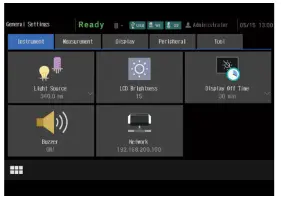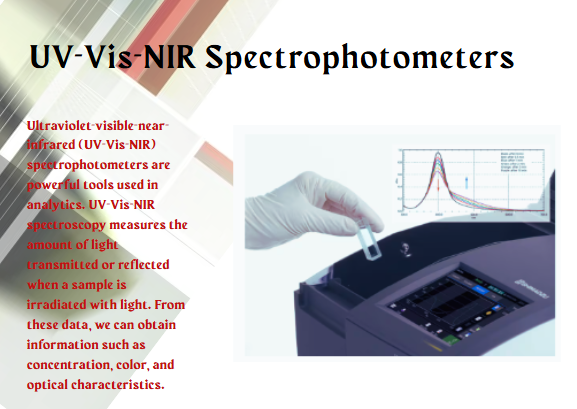UV-Vis-NIR Spectrophotometers are powerful tools used in analytics. UV-Vis-NIR spectroscopy measures the amount of light transmitted or reflected when a sample is irradiated with light. From these data, we can obtain information such as concentration, color, and optical characteristics.
Ultraviolet-visible-near-infrared (UV-Vis-NIR) spectrophotometry
Ultraviolet-visible-near-infrared (UV-Vis-NIR) spectrophotometry is a powerful analytical technique widely used in scientific and industrial laboratories. Known for its versatility, accuracy, and cost-effectiveness, UV-Vis-NIR spectroscopy measures how much light a sample transmits or reflects across the ultraviolet (UV), visible (Vis), and near-infrared (NIR) wavelength ranges. From these interactions, scientists can extract critical information such as a sample’s concentration, color, and optical properties.

How UV-Vis-NIR Spectrophotometry Works
UV-Vis-NIR spectroscopy operates on the principle of light absorption and transmission. When light is directed onto a sample, some of it passes through (transmittance), some is absorbed (absorbance), and some may be reflected. UV-Vis-NIR spectrophotometers measure the difference between the incident light and the light that emerges from the sample, helping identify the molecular structure and quantity of substances present.
One of the core scientific laws used in this method is the Lambert-Beer Law, which states that the absorbance of light by a solution is directly proportional to the concentration of the solute and the path length of the sample cell. This principle enables precise concentration measurements, even at very low levels.
Most UV-Vis-NIR spectrophotometers operate across a broad spectral range—typically between 185 nm and 3300 nm—covering ultraviolet, visible, and near-infrared light.
Key Components of a UV-Vis-NIR Spectrophotometer
A standard UV-Vis-NIR spectrophotometer includes the following core components:
- Light Source: Commonly deuterium lamps for UV range and tungsten-halogen lamps for Vis-NIR range.
- Monochromator: A device that separates light into its component wavelengths to focus on a specific range.
- Sample Holder: Varies depending on whether the sample is a liquid, solid, or thin film.
- Detector: Captures and converts the light that has passed through or reflected from the sample into electronic signals for analysis.
- Data Processor: Converts signals into a chromatogram or absorbance spectrum for qualitative and quantitative interpretation.
Modern UV-Vis-NIR spectrophotometers, such as those from Shimadzu, offer automated calibration, self-diagnostic systems, extended wavelength coverage, and high-resolution detectors for accurate and reliable analysis.
Applications of UV-Vis-NIR Spectroscopy
Thanks to its ease of use and minimal sample preparation, UV-Vis-NIR spectrophotometry is used across a wide range of industries:
1. Pharmaceutical Industry
- Used for impurity analysis, quality control, and stability testing.
- Conforms to international standards such as USP (United States Pharmacopeia) and EP (European Pharmacopeia).
2. Materials Science
- Useful for thin film characterization, nanomaterial research, and polymer analysis.
3. Environmental Monitoring
- Ideal for testing water quality, identifying pollutants, and analyzing contaminants.
4. Food and Beverage Industry
- Ensures safety and quality by detecting colorants, additives, and contaminants in food products.
5. Biotechnology and Clinical Research
- Tracks cell growth, measures hemoglobin absorbance, and analyzes various biomolecules.
Frequently Asked Questions (FAQs)
✅ What is a UV-Vis-NIR spectrophotometer?
A UV-Vis-NIR spectrophotometer measures light transmission or reflection after irradiating a sample. It’s used to determine concentration, color, and optical characteristics of a sample.
✅ What is the principle of UV-Vis-NIR spectroscopy?
It is based on the absorption of light when molecules in the sample transition between energy states. The spectrophotometer compares the incident light to the transmitted light, revealing chemical information.
✅ What can UV-Vis-NIR spectroscopy detect?
It detects a variety of molecules including organic compounds, nanoparticles, and biological substances. It’s widely used in food analysis, clinical diagnostics, and research laboratories.
Final Thoughts
UV-Vis-NIR spectrophotometry is an indispensable tool in modern analytical science. With its non-destructive nature, ease of use, and broad application range, this technique continues to drive advancements in pharmaceuticals, materials science, environmental monitoring, and beyond. Whether you’re analyzing a complex formulation or tracking minute impurities, UV-Vis-NIR spectroscopy provides the precision and reliability needed for cutting-edge research and quality assurance.https://iampharmacist.com/2025/05/10/overview-of-21crf/

